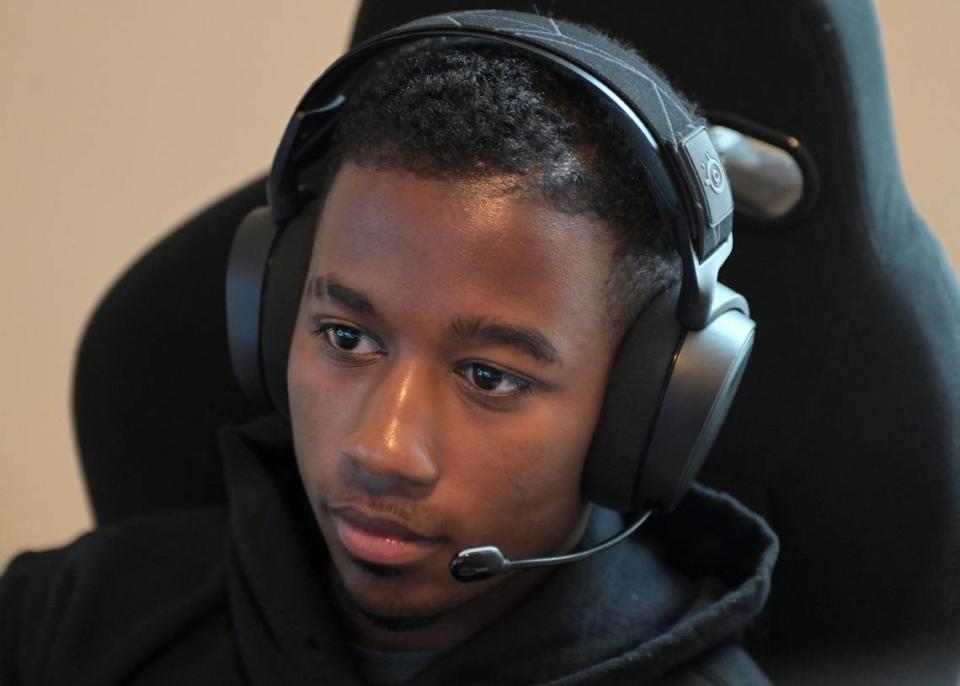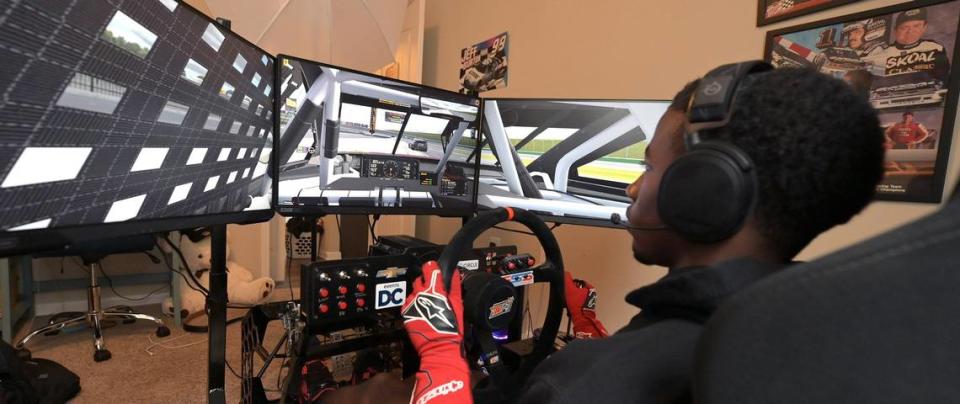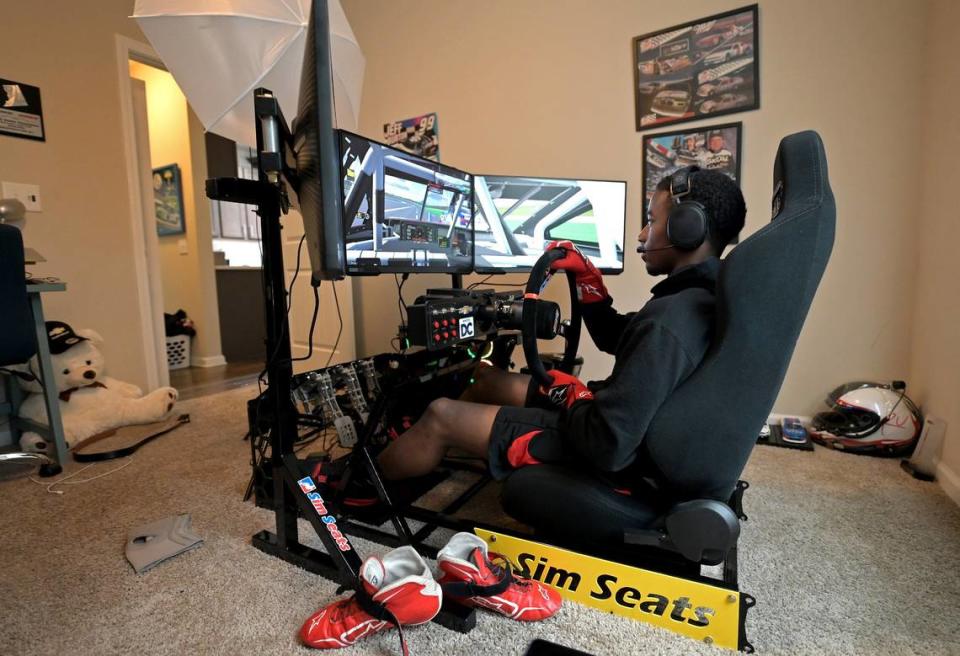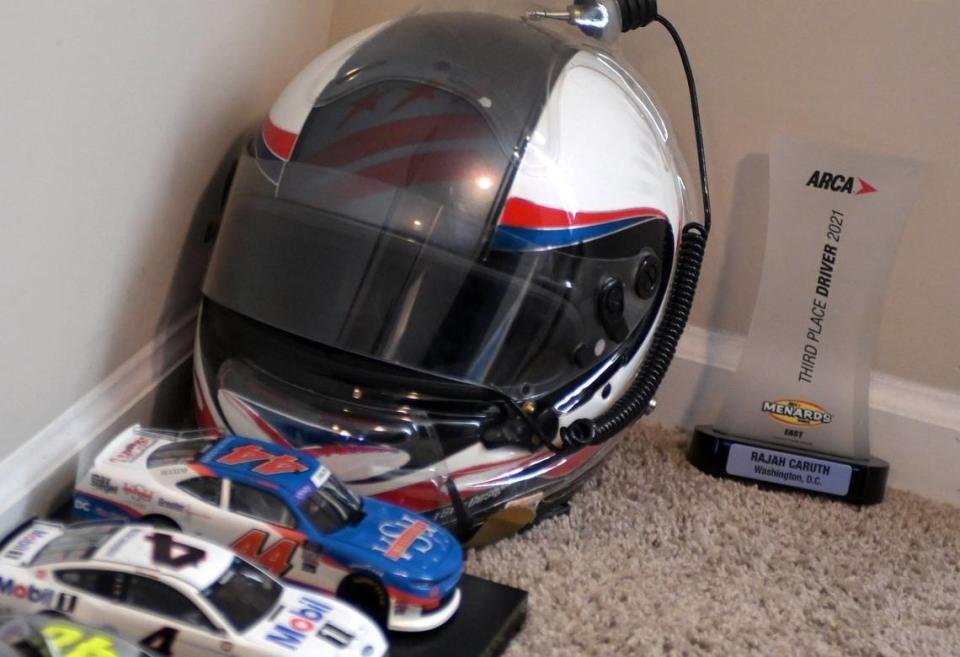Driver Rajah Caruth kicked open opportunity’s door. The rising star wants more.
- Oops!Something went wrong.Please try again later.
Rajah Caruth’s red-gloved hands gripped the wheel as the young ARCA Menards series driver navigated a rapidly approaching curve on the Mid-Ohio Sports Car Course.
His right hand moved with the comfort of repetition, flitting between the wheel and the stick shift to his right, balancing both in an effort to keep the tire’s traction through the turn.
After many such balancing acts, Caruth finished his practice run. Satisfied with his performance, he took a break.
His “break” didn’t involve taking off his helmet and exiting the car. Instead, he pushed his headphones to the side and turned to the iPad at his right, looking at his lap times and data to compare them to previous runs.
The virtual race track is Caruth’s training ground, a pivotal link between his past and his present. iRacing, a racing simulation video game, helped jump-start his racing career and now prepares him for real-life races.
Caruth races full-time for Rev Racing — and leads the standings — in the ARCA Menards series, one of the main feeder leagues into NASCAR’s top three series. He also races part-time in NASCAR’S Camping World Truck and Xfinity series.
It’s an impressive amount of success for someone who didn’t grow up in a part of the country that prioritized racing, but the 20-year-old isn’t satisfied.
In fact, he’s tense.
The Washington, D.C., native hasn’t won a race in more than a year — a fact that gnaws at the ultra-competitive driver.

“Literally everybody I’m racing against has won already. And I’m first in points and I haven’t won yet. Going in the race shop and seeing my teammates’ win banners … it’s just, as a competitor, frustrating,” Caruth said. “I feel like I’ve got my ducks in a row and I still haven’t won yet.”
Despite that frustration, Caruth’s story remains one of opportunity.
His story is about how a racing-obsessed kid who grew up in an area without any race tracks, and without any connections in an industry historically unwelcoming to Black people, saw a sliver of hope to reach his goals.
That kid, one of the few Black drivers in the sport, found that door of opportunity slightly ajar.
Then he kicked it wide-open.
A racing desert
Caruth’s hometown of Washington, D.C., doesn’t have a racing scene or tradition, which forced the then-middle schooler to create his own circuit.
Armed with a Fujifilm camera, the 12-year-old created stop-motion video races from his bedroom.
The roads and barriers were constructed out of cardboard and paper, with marker-drawn start and finish lines, a hand-drawn logo placed at the center of the track and a towering leaderboard. Tracks sprawled across his room, Caruth’s mother Samantha said, making it so that you couldn’t walk into his bedroom.
Cars crashed into each other and the cardboard walls, sending puffs of cotton ball-created smoke throughout the track. Caruth organized the stop-motion race like a real NASCAR broadcast, shifting camera angles, giving “onboard” views and announcing 17 row-by-row introductions of the drivers.

“Welcome to Frankfurt Motor Speedway,” Caruth narrated as Calvin Harris’ “Summer” played in the background. “Today’s presentation is the NAPA Auto Parts 300.”
His love of motorsports began when he watched the movie “Cars,” and he was hooked. The first NASCAR race he watched on TV was the 2009 Carfax 250. Caruth was 7 years old.
“It was a Nationwide Series race at Michigan, Brad Keselowski won in the Go-Daddy Car,” he recalled instantly.
Caruth has an immense knowledge of the sport. He can go backwards and name every NASCAR Cup Series champion since 1988. He’s a human version of the book his parents got him — a NASCAR Encyclopedia. A young Caruth pored over that book, devouring it until it was tattered and torn.
“He can tell you anything about any era of NASCAR, any driver, any track, any sponsor, I mean, crew chief, you name it,” Caruth’s father, Roger, said. “So he’s actually a student of the sport.”
Any time a teacher gave him the chance to do a school project, Caruth immediately turned to NASCAR, doing projects on Wendell Scott, the HANS device and a senior project video on “How American Stock Car Racing Can Stay Relevant.”
Despite his love for NASCAR, Caruth didn’t have regular access to race tracks.
That’s when he turned to iRacing, an online racing video game that uses real-world cars and tracks. After the end of his sophomore year in high school, Caruth wanted to join the Ignite Series, an online youth circuit organized by NASCAR and iRacing.
There was just one issue: He didn’t have a rig. He needed a desk, pedals and a steering wheel, all of which could cost around $2,000. His parents asked him to raise the money himself.

“For us, it was less a part of the money, more so that he has to put in the effort,” Samantha said.
That’s what Caruth did. He made a pitch video and put a fundraiser on GoFundMe, sending it to family and friends. Soon enough, he raised the money required to get the iRacing rig and was set up to race in the Ignite Series.
However, his computer at the time was a Mac and the program only ran on Windows. Undeterred, Caruth threw himself into the internet and spent an entire day “splitting” the hard drive in two, partitioning half for Windows and half for the Mac software.
“No,” he said when asked if he’d done computer projects before. “I’m not a computer guy at all.”
Caruth joined the Ignite Series and finished 20th, an accolade he used as the focal point of his initial application for the 2020 NASCAR Drive for Diversity Driver Development program.
“I knew that (program) was my only chance,” he said.
After the application and an on-track assessment, Caruth was accepted and found himself where he always wanted to be — behind the wheel of a real race car.
Resistance and stiffness
The carcass of a race car dominates a corner of Caruth’s Concord bedroom. The driver’s seat is stationed low to the carpeted floor. Three silver pedals and a black steering wheel center the heart of the console. To its right are a chrome stick shift and a dashboard with an assortment of toggles and buttons.
But this “car” runs off a CPU jutting off to the side — a hulking box with three spinning light-up fans, constantly shifting colors as the fans whir in the background.
Three monitors replace windows and a windshield, enveloping Caruth in his iRacing rig.

Despite the relative realism of iRacing, the adjustment between virtual and real-life cars forced Caruth to adjust.
Before, he only had to process information through his eyes, ears and hands. In a real car, he had to learn to feel the vehicle’s movements beneath him, what’s commonly referred to in racing as the “seat-of-the-pants feel.”
“Basically, I can feel the car through my hips and my body, how the weight transfers, how the tires are in the race track,” Caruth said.
He slowly found his groove, learning to navigate not only the race track, but also the majority-white space that is NASCAR.
Samantha Caruth initially hesitated to let her son participate in NASCAR because of its culture, one she knew had a history of being unwelcoming to Black people.
“Who wants to send their child out into the world into a place that we think is already designed to not include Black people?” she asked.
Caruth dealt with many of the microaggressions that minorities experience in majority-white workplaces, whether people called him well-spoken in a surprised tone, or otherwise talked down to him at race tracks.
In the summer of 2020, the killings of George Floyd, Ahmaud Arbery and Breonna Taylor sparked Black Lives Matter protests across the globe, bringing up issues like mass incarceration, segregation and voter disenfranchisement.
Caruth remembered talking to many people in racing who either denied the existence of the problems or dismissed it as an everyday occurrence.

He’s had to deal with the perception from some racing fans of being NASCAR’s appointed diversity kid, a belief that still nags at him.
“Unfortunately, it may be that I’m just another diversity kid that NASCAR is pushing,” he said when asked what the average NASCAR fan would say about him. “That may not be the case, but that’s kind of how I see it.”
Even though being in this industry and making it his life’s work is all he’s wanted. Even though he’s sacrificed and worked hard. Part of him feels he’s still not going to be seen the same by others.
He’s slowly getting more comfortable speaking up and embracing his Black Caribbean culture. Caruth’s sported the Winston-Salem State University logo and the St. Vincent and Grenadine government’s brand on his car in races, representing the HBCU he attends and his heritage.
“I’m trying to work on my own identity, because I don’t know what it is,” Caruth said.
He does know that with how much dedication he has for it, that racing will be a large part of that identity.
A competitive spirit
It’s that work, motivated by a competitive spirit, that’s allowed the driver to continue his success.
His winless streak — dating back to May 2021 — echoes in his mind every single day, multiple times an hour, a constant reminder to do better, to push harder.
Part of that comes in his iRacing runs. Caruth spends around an hour and a half a day in that skeleton, mostly preparing for upcoming races. On Tuesday, he worked on the Ohio course, where he’ll race on July 8.
As the practice laps ended and qualifying races began, Caruth narrowed his focus. Headphones and racing gloves slid into position. His gloves match the old racing shoes he’s wearing.
The rig’s pedals mimic the resistance and stiffness of a real car while the wheel constantly fights for control, wresting itself out of his grip.
A bad turn prompted a sharp exhale, but Caruth is largely silent during his run.
“Finally,” he said when he made a solid turn with the required precision on the wheel and stick shift to keep his tires underneath him. He’s past the qualifying races and into the 20 laps making up the final race.
This is Caruth’s last run for now. It’s past 9 p.m. and he’s hungry.
In just the third lap, the wheel escaped from his grasp, spinning wildly as the car lost traction and careened into the tire-filled wall.
“And how the mighty fall,” Caruth noted, before detaching the wheel and placing it face down on the console.
That’s where it’ll rest till his next run, whether that’s in a day or an hour.
Either way, he’ll think about racing. How to improve, how to get that elusive victory and how to make sure the door he kicked open stays that way.
“I’m obsessed with (racing),” Caruth said. “And it’s all I think about. It’s what I wake up thinking about, it’s what I go to bed thinking about, it’s what I daydream about, (building a legacy as an accomplished driver) is what I work toward.”

